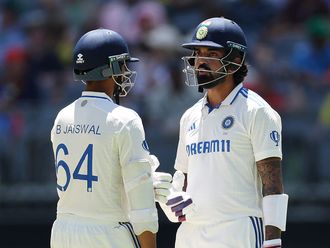
Dubai: England arrived in India with plenty of negative comments surrounding their preparations for the five-Test series considered one of the toughest assignments in world cricket.
India’s fortress are difficult to breach on spin-friendly conditions. Former Australian captain Steve Waugh even called it the final frontier. India have lost only thrice in 46 Tests at home since 2013 before the Hyderabad Test and hence a perfect start was extremely important. The Three Lions bared their teeth and caught the hosts on the wrong foot to win the first Test and extend their winning run to 14 wins in 19 Tests under the new management of skipper Ben Stokes and Brendon McCullum with their ultra-aggressive Bazball approach. It is still early days and another four Tests remain, but the Indian fans are disappointed as it is hosts’ first-ever defeat in a Test at home after leading by 190 runs in the first innings.
Ollie Pope with his counter-attacking 196, filled with sweep, reverse-sweep and audacious scoops, and debutant Tom Hartley with seven wickets in the second innings for a match-haul of nine for 193 were the architects of England’s stunning win. Gulf News takes a look at five reasons for India’s loss in the first Test.
1. England’s immaculate preparations and smart game plan
England, away from the prying eyes, devised their game plan for the Test series in Abu Dhabi, shunning the tour games. They just arrived three days prior to the first Test in Hyderabad after a 10-preparatory camp in UAE. During the camp, the Three Lions were simulating match situations to finding answers to the probing Indian spin quartet on specially prepared spin-friendly, low-bounce pitches at Sheikh Zayed Sports Hub. So when England players took to the field, they were match ready, while the Indian team did not show the required discipline on all three departments of the game. Skipper Stokes even was brave enough to pick just one pacer in their playing XI. England were prepared to use sweep and reverse sweep as their main weapon against the Indian spinners. It is nothing new. England batters have swept the Indian spinners out of the attack successfully in the past too. Graeme Flower and Mike Gatting played the sweep shot to good use to score double centuries at Chepauk in Chennai, while Graham Gooch took the match away from India with his sweep shots in the 1987 World Cup semi-finals.

2. Wayward Indian bowling
Indian spinners didn’t do their homework well and were wayward against the attacking England batters. They made the visiting batters’ job easier by bowling quicker and trying different variations on a pitch that was doing everything. Joe Root and Hartley displayed in this Test that the key to be successful is to keep it simple by bowling a stump to stump line, which put the Indian batters in a spin. While the Indian spinners were operating at speeds of late 80 to early 90kmph, England spinners were bowling at late 70 to early 80kmph, there by getting more revolutions and grip from the surface. Indian spinners conceded 3.81 and 4.11 runs per over in both the innings, which shows that they were not able to keep the England batters under check and allowed them the room to continue their bold ways.
3. Not putting a price on their wickets
Almost all of the Indian batters were guilty of throwing their wickets away during the first innings. A little discipline could have helped them spend more time at the wicket and a big score could have given them the required confidence while facing England in the second innings. Eight of the top nine batters got the start and after doing the initial hardwork, they frittered away the advantage. On the contrary, in the second innings, the Indian batters adopted an ultra-defensive approach. By going into the shell, they let the inexperienced English spinners dictate terms. A bolder approach would have put more pressure on the bowling, which could have cracked under pressure. The last three or four batters tried to play some big shots and were rewarded with some quick runs. Left-hander Axar Patel, who was sent in as a pinch-hitter, also adopted a cautious approach and failed to break the shackles of the England spinners.

4. Catches win matches
It might be an adage, but it holds true every single moment in a cricket match. Patel dropped a simple chance off Pope when the batter was in full flow at 110, the scores reading 257 for five. Pope and Ben Foakes had put on a 94-run partnership for the sixth wicket and were just 67 runs ahead. A wicket at that stage would have halted England’s march and probably reduced the target for India. Pope went on to add another 86 runs and in the process put on some crucial partnerships. While fielding Pope took two sharp catches to dismiss Yashasvi Jaiswal and Shubman Gill and the extraordinary run out by Stokes to dismiss Ravindra Jadeja tilted the match in England’s favour.

5. Pitches to suit home advantage
This pitch at Hyderabad is not a bad one by any means, but certainly had plenty of assistance to the spinners from day one. It is the second occasion India have been caught napping on “tailored” wickets. In the 50-over World Cup final, the low-bounce wicket was utilised to perfection by Australian pacers, bowling the cutters and slow bouncers. Similarly, with careful planning and assessment on the conditions, good catching, smart bowling, sticking to the basics of stump to stump line, and constant pressure on a worn out fourth day pitch was enough for England to win by 28 runs after a late fightback from lower order batters only helped in reducing the margin of defeat.












